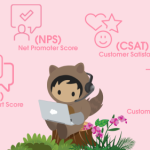Customer service teams across the globe are learning to adapt to the new normal. They’re not only introducing remote working models, but also rethinking their operational and channel strategies.
In recent times, the relevance of customer service teams has only increased, as their responsibilities go beyond just addressing customer queries or issues. They’re also expected to build customer loyalty and trust by personalising customer interactions, and making them more transparent.
At the same time, service operations are changing, new service channels are being introduced, and customer demands are increasing.In this context, companies should rethink the customer service KPIs framework used to assess their service teams’ performance.
The definition of success needs to be in line with new expectations and business priorities. For years, companies have relied on traditional success metrics such as customer satisfaction (CSAT), average handling time (AHT), and net promoter score (NPS).But today, there are other customer service KPIs that can provide a more holistic picture of a service team’s performance.
Below are five such KPIs:
1. Customer effort score
A customer effort score (CES) is typically defined as the effort customers need to put in to get their queries or issues resolved. It is highly correlated with customer loyalty. According to Gartner, Inc. 96 percent of customers with a high-effort service interaction become more disloyal when compared to just nine percent with a low-effort experience. And 94 percent of customers with low-effort interactions are more likely to repurchase, as compared to four percent of those who engage in high-effort interactions.
Increasing the number of customer servicing channels does not necessarily increase customer loyalty. Rather, it might end up confusing some customers. Hence, it is more important to understand how easily customers can find what they’re looking for, and how many times they need to reach out to a company for answers.
Customer effort can be reduced in various ways—for instance, by designing simpler processes and customer experiences; also, by empowering service teams to not only resolve the customer issue at hand, but proactively offer guidance on potential issues that could arise.
2. Channel performance and split
Service leaders across the globe are trying to be available on their customers’ preferred channels, whether that’s social media, email, or WhatsApp. As the number of channels increase, each one’s performance must be evaluated in terms of backlogs, time to resolution, customer feedback, and volumes being serviced. This data can help companies optimise resource allocation, while also addressing service gaps. For example, if a self-service channel’s usage is lower than desired, companies can collect feedback from customers, and use it to devise strategies that improve the self-service experience.
3. Customer retention rate or attrition rate
Customer retention rate (CRR) is another critical KPI for many companies, especially subscription-based businesses. As per the 2020 CallMiner Churn Index, contact centre performance drives both loyalty and churn. 90% of consumers said they are likely to stay loyal after a positive call centre experience; 7% said they are likely to switch after a negative one. CRR, or more importantly, customer attrition rate, is influenced by how satisfied customers are when they interact with a company. In fact, as pointed out by Gartner, Inc. customers are four times more likely to leave a service interaction disloyal than loyal.
In other words, a good interaction may not necessarily increase customer loyalty, but a bad interaction is highly likely to lead to customer attrition. Hence, it’s very important for service leaders to keep track of this metric, proactively monitor possible attrition and train their agents to improve each customer interaction.
4. Agent satisfaction
Many companies invest time and effort in improving customer satisfaction. But when it comes to their own agents’ morale, they don’t pay as much attention. In these times, when customer service teams are having to manage a high number of new and complex issues, making agents’ jobs easy is of utmost importance. Companies need to gauge their agents’ satisfaction levels, and support them as much as possible—for example, by empowering them with the right technology, or extending timely help, or keeping them engaged. This can have a direct impact on improving agent productivity metrics, such as AHT, as well as customer satisfaction metrics such as CSAT and NPS.
5. Cost per interaction
Every interaction between a customer and an agent is a cost to the company. Different service channels have different service costs, with phones typically being the most expensive. By understanding the cost per customer interaction on each channel, service leaders can better design their customer experience strategies. For example, digital channels such as WhatsApp, chat, and social media are comparatively low in cost. So, companies might want to promote more customer interactions on these channels, and train agents on managing conversations there.
How can Salesforce help?
Salesforce has been the market leader in customer engagement solutions for more than a decade with Gartner recognising Salesforce as a leader in their 2020 Magic Quadrant for CRM Customer Engagement Center. With Salesforce Service Cloud, companies can not only track but also improve customer service KPIs and metrics by:
- Reducing customer effort through simple processes and self-service channels such as communities and bots
- Tracking the performance of different service channels with smart analytics and pre-built dashboards
- Empowering agents to reduce customer attrition and build trust with a complete 360-degree view of customer information on service consoles
- Improving employee engagement and productivity with automation, AI-driven insights, and pre-built service tools
- Building an omni-channel service experience, and adding low cost digital channels

























